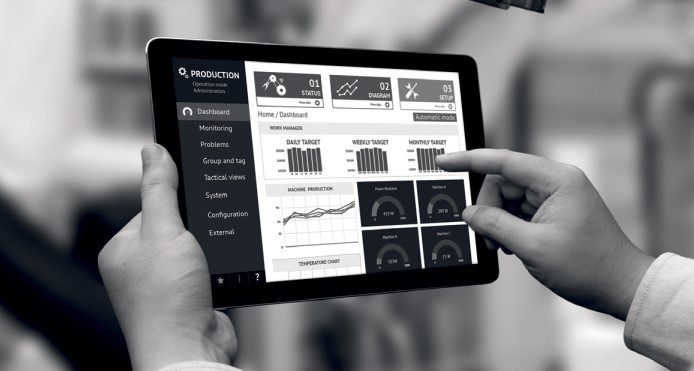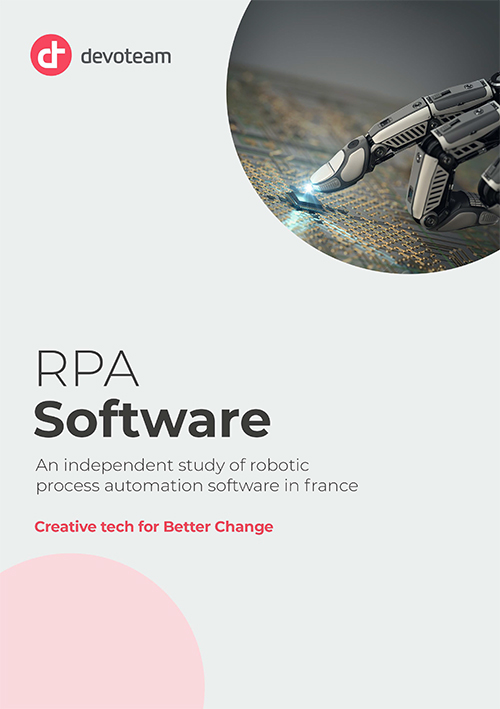RPA software is known for its capacity to support fast solutions that result in positive outcomes, which can be managed into visible and tangible benefits.
The business outcomes that arise from applying RPA enable new business capabilities. These capabilities can be transformed into business benefits. In various ways, the benefits support cost minimising or new business value, or, in some cases, both.
Whether the main driver for introducing RPA is a high automation potential or an inflexible IT situation, the potential outcomes are often similar. The extent of the outcome potential can, however, vary extensively depending on the IT situation and use of RPA.
The potential positive outcomes and benefits of RPA are listed below. In reality, these outcomes and benefits often overlap and they are, to a certain extent, chained together.
It is however, important to be aware of the different character of these in order to realise the full business potential of RPA.
Figure 3. From RPA use case to business effect

The typical potential outcomes of RPA initiatives are:
- Higher throughput:
The RPA robots work around the clock, resulting in faster process performance. This enables a higher throughput of performed tasks and processes.
- Increased capacity:
A higher throughput enables an increased capacity to perform more processes and tasks.
- Time-saving:
LRPA saves time both in regard to process execution and in terms of saving employees time on manual process handling.
- Reduced need of labour:
The robots essentially take over tasks that were previously performed by employees, and while the RPA robots still need to be scheduled, run and monitored, the reduced need for human interaction is a key outcome of RPA initiatives.
- Better accuracy:
RPA robots ensure that every process is handled accurately and similarly, thereby eliminating errors due to human process handling.
- Better IT coherency:
Especially in cases with inflexible or complex IT situations, the coherency of the IT portfolio in scope can be improved considerably using RPA as integrator between otherwise incoherent IT systems.
- Processed data for analysis:
The automation of the processes results in more processed data than when the processes were performed manually. These data enable detailed data analysis of the process execution and efficiency.
- Transparency:
When using RPA, the processes leave a data trail providing full transparency into the process handling.
The main benefits that can be achieved with the RPA outcomes are:
- Reduced costs:
Reduced costs can be the result of several of the outcomes, such as higher throughput, time saved, better accuracy and reduced need for labour.
- Higher productivity:
The capability of a higher throughput enables a higher productivity in process handling. Furthermore, the reduced need for human interaction boosts productivity, as the employees can spend their valuable time on other tasks.
- Quality increase:
Quality increases through better accuracy in the process handling.
- Better compliance:
RPA is an effective tool to ensure process handling according to specific rules or laws, which can enable companies to comply with regulations that may have proved difficult to comply with manually.
- Faster time-to-market:
The ability to increase production and reduce processing time makes it possible to launch products and services more rapidly.
- Higher customer satisfaction:
Higher customer satisfaction can be enabled by a higher throughput and lower process time reducing the customers’ waiting time, an increase in quality, and the ability to provide full transparency in processes. Furthermore, higher customer satisfaction can be achieved by using RPA outcomes to increase value to other business areas hence increasing the customer satisfaction.

Case: Finance – Service Desk Processes
Service desks can suffer from repetitive workload, especially in regard to creating tickets from emails. RPA has been used to automate the process and extract information from emails to create tickets and showed a reduced workload of up to 98%.
Case: Public sector – Governing Processes
A department in public government made an assessment of the RPA potential in governing processes. The assessment showed significant potential for automation, especially within nine areas in customer service, including mail-handling, reprocessing cases and company registering. Up to 1,300 of 2,000 hours of manual labour could potentially be saved. The potential was further qualified by carrying out a Proof of Value on RPA applied on a small scale within a strict scope. This revealed a notable reduction in cost and hours spent on tasks.
Managing benefits to support the desired business goals
To reach the desired effect in relation to business goals, it is essential to focus on how the transformation of outcomes into benefits is managed. If the outcomes are not managed into benefits that support the business goals, the potential of the new capabilities may not be fully realised, and perhaps lost entirely.
For example, an outcome such as reduced need of labour can be realised as a benefit in several ways. For instance, one way is to cut down on employees to cost-minimise, while another could be to redirect employee resources to other tasks that add value for the customers, thus supporting business goals concerning customer value.
In the same manner, an outcome of higher throughput can not only be managed into gaining a faster time-tomarket, but also increasing productivity. If, however, the potential to increase productivity is not utilised, it may be lost.
As such, it is imperative for an organisation to be clear about the main business goals of implementing RPA and to dedicate time and attention into realising the desired benefits. Moreover, clear communication of the desired goals and opportunities of implementing RPA is known to ameliorate potential fears among employees that the robots threaten to take over the employees’ jobs.
Benefits management and realisation are typically the responsibility of the business units in close cooperation with RPA experts. They are the ones who run the RPA robots and, as such, are capable of managing the outcomes into the desirable benefits by dedicating their focus to making the most of day-to-day production. In other words, they own RPA transformation.
Close cooperation with the IT department is often necessary to ensure coherence with the IT portfolio, data management, IT security, etc.
Case: Generic – Data Migration and Conversion
In a specific case, 12 employees were employed to manually update information from their IT system to another system. Instead, RPA was implemented to perform these tasks.
The extensive backlog of cases to be migrated was cleared and cost reductions due to reduced manual labour were realised within the first 3 months.
Investment and running costs
The potential benefits of RPA are known to be achieved rapidly and with relatively low costs compared to traditional IT initiatives. Important factors that support the low costs of getting started with RPA are:
- Implementing RPA does not require a large IT technology investment
- No major IT changes to existing systems are needed
- Investments for development and operations setup are limited
- It is possible to implement RPA in a short period of time
- The organisational impact of the change is limited to only involving employees who are directly affiliated with the process handling.
When investing in RPA software, it is important to be aware of the ‘hidden’ licence agreements and costs. Besides the expected licences for the RPA software itself, most commonly the RPA robots also need licences to access and operate the targeted IT systems and applications – just as any human user would. Moreover, if an Identity & Access Management solution has been deployed to control user access and rights, the RPA robots also need to be counted in that solution.
Case: Software Providers – Testing
RPA robots are efficient tools that can ease the technical burden and reduce the lengthy execution times which are often involved when testing new software.
Robots can be used to test the implementation of new software, applications, website updates, APIs, user interfaces, database, installation, network, and much more. Several RPA solutions have key features that support the testing of each process step, the performance of the solutions, integrations to other systems, and high-volume transaction tests.
The tests are performed rapidly and result in detailed data for the QA department to verify, make improvements if needed, and rerun the tests.
Case: Public sector – Employee Contract Administration
In public administration, a line of requirements regarding employment contracts ensure that the contracts are compliant to the specific laws and regulations at the time.
As these regulations change regularly, it is necessary to ensure compliance checks on the existing contracts by reviewing the relevant documents.
Performing this manually is a time-consuming task due to the high volume of data involved. For this reason, the checks were often insufficiently carried out.
To ensure both efficiency and greater compliance, a Danish municipality developed an RPA robot which has been programmed to review all the contracts and related documents.
The RPA robot extracts the relevant information from different sources, checks for compliance according to the current set of rules, and highlights the contracts that need revising by the legal department.
Case: Sector Public – Process Compliance
RPA features can be used to follow process compliance after the implementation of new IT. For example, data on end users’ actual use of the digital processes can indicate whether the processes are followed or whether there are user patterns that indicate problems with the process design.
This can be used to both improve the systems and to monitor compliance while gaining concrete facts on the realisation of the intended positive business outcomes and potential benefits. The data generated from the RPA robots offer excellent material for forming and following business Key Performance Indicators (KPIs) for a longer period of time after the implementation supporting benefits realisation.
Can companies using BPS/BPO take advantage of RPA?
From the Millennium onwards, Business Process Shoring (BPS) and Business Process Outsourcing (BPO) to low-cost countries has been a preferred approach for many companies to lower their costs of business operations.
The BPS/BPO approach has been both used for core manufacturing processes leading to offshoring or nearshoring of entire production facilities, and for administrative back-office processes resulting in the creation of shared service centres, typically in nearshoring countries. Today, many larger international companies in the Nordics have a shared service centre in Eastern Europe.
Moving business processes to nearshore countries will typically lower the labour costs to around 30-50% of the comparable labour in a Nordic country. Moving the business processes to offshore countries will reduce labour costs to 15-30% of the comparable labour. Of course, the saving is offset by the investment required to move the business operation and by the costs to additional management resources needed to manage the BPS setup.
Compared to BPS/BPO, the deployment of RPA is not a large upfront ‘lift & shift’ investment or a major transition to an outsourcing partner, but instead a continuous series of smaller automations.
Consequently, the investment in RPA is considerably lower than an investment in BPS/BPO. In addition, no additional management resources are needed to manage RPA as with BPS/BPO, and with RPA, the comparable cost against the labour cost is lower than the 15-30% for offshoring.
Accordingly, the experience from companies already having a BPS/BPO operation is that here RPA is also able to drive further business benefits including further cost reductions.

